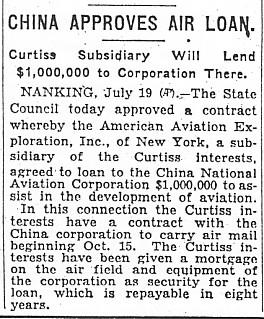
CNAC HISTORY
|
Background music to this page can be controlled here. "Thanks For The Memories", Guy Lombardo |

The Contract |
|
From The Dragon's Wings by William M. Leary, Jr. (Copyright © 1976) "American business enterprise took the lead in advancing a program to inaugurate commercial air service in China. Curtiss-Wright, the leading aeronautical corporation in the United States at the time, founded the China National Aviation Corporation (CNAC) in partnership with the Chinese government in 1929. Subsequently taken over by Pan American Airways in 1933, CNAC pioneered commercial air service throughout the Middle Kingdom until the airline's demise in 1949. Only the formalities remained. (William) Bond flew to Hong Kong for the last meeting of CNAC's Board of Directors. The board assembled in Room 231 of the Hong Kong and Shanghai Bank Building on December 31 and confirmed the terms of purchase. Later that evening, Bond, representing the American shareholders, and C.S. Nibson, acting for the Chinese owners, ratified the board's action on behalf of the airline's stockholders. Shortly after 8 P.M., Saturday, December 31, 1949, the China National Aviation Corporation passed out of existence." |
|
From Wings Over Asia, Volume IV (Copywright @ 1976) "The slightly over two decades of China National Aviation Corporation's (CEENAK to the GI's) existence throughtout the 1930's and 1940's might be divided into segments depending on the base of operations. It started in Shanghai and remained there until mid-1937 when the Japanese invaded China. The next base was in British Hong Kong until Pearl Harbor, December 1941, at which time Hong Kong was occupied by the Japanese. During the war years of 1942 through 1945 Calcutta was headquarters. The move back to Shanghai was made early in 1946 where it remained until the Communist take-over. |
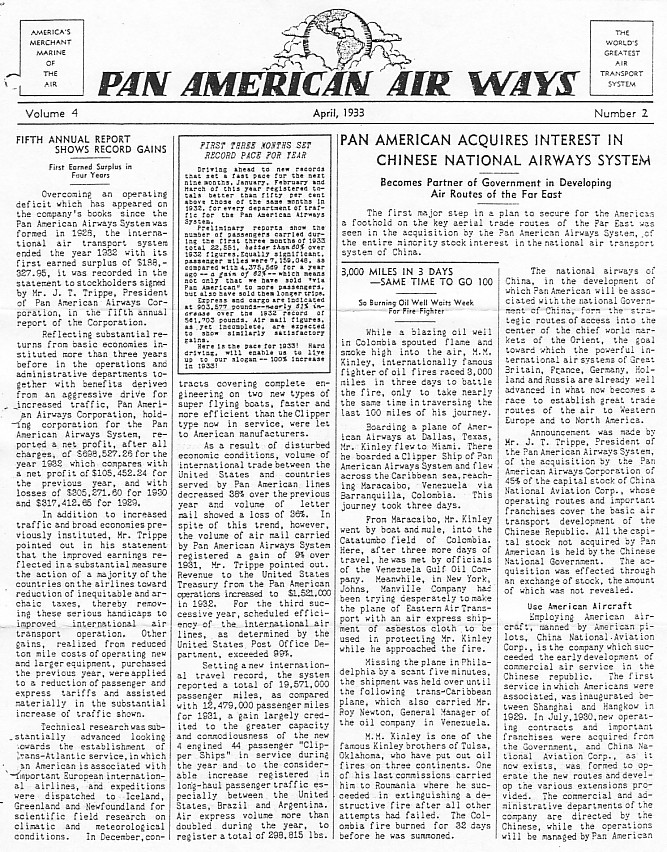 Article courtesy of San Francisco Airport Museum |
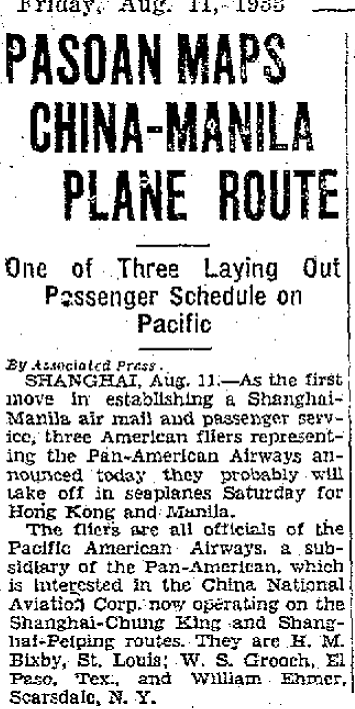
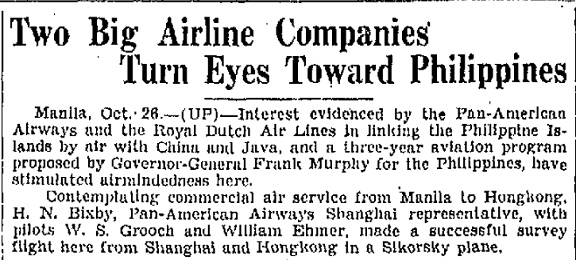

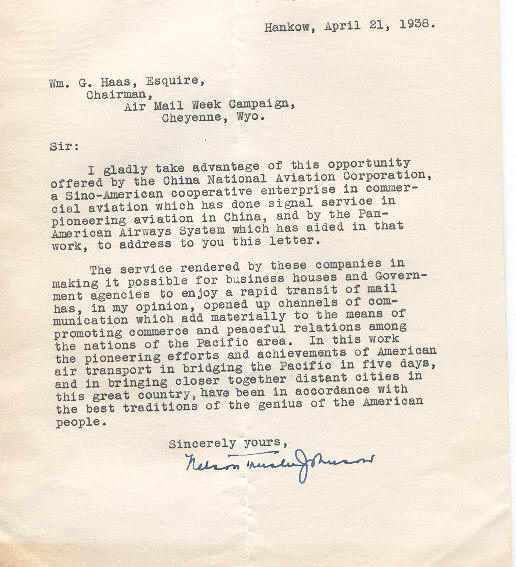 December 11, 2003 I sure do remember him: Nelson Trusler Johnson was U,S. Ambassador to China. Since the letter was sent from Hankow it must have been during the time the government was moving from Nanking to Chunking. I can't quickly put my hands on anything that fixes the date, but I feel cerain that time frame is correct. My father, Willys Peck, was on Mr. Johnson's staff. Mr. Johnson later went to Australia as Minister. I don't know about the Wyoming address, it may just be a coincidence but Mrs. Johnson came from a prominent Wyoming family. I do enjoy your communications. Happy Holidys to all the CNAC family. Damaris Reynolds 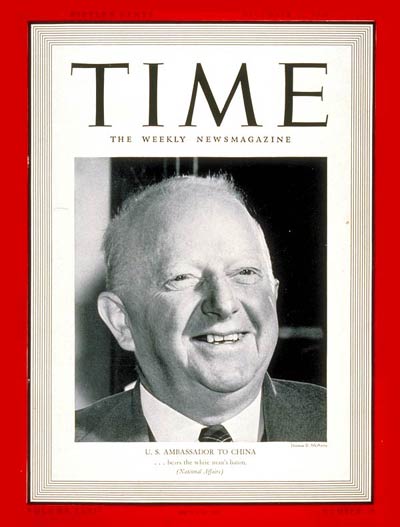 Nelson Thurston Johnson U.S. Ambassador to China Time Magazine Cover December 11, 1938 |
|
Aviation History, November 1998 and is reprinted here with permission from the publisher, HISTORYNET. and For more information or to subscribe visit historynet.com. Well worth the read... |
|
March 25, 2000 From Jim Dalby CHINA NATIONAL AVIATION CORPORATION The China National Aviation Corporation (CNAC) played a significant role in the history of modern China. Originally a corporation formed, in 1929, by the Chinese government and the Curtiss-Wright Corporation, by 1933 the airline was owned by the Chinese Government and Pan American Airways. Shortly before America's entry into the Pacific war, CNAC pioneered the famous routes over the Himalaya Mountains (the Hump) between India and China. When the Burma Road was cut off by the Japanese Army during WWII, these routes became the only source of outside supply for China. As part of the Army Air Force Air Transport Command, CNAC's operation of a military air-lift over the Hump became one of the more glorious chapters in WWII history. It was the world's first major airlift, and it was a pilot's nightmare. The 500+ mile routes traversed some of the most treacherous terrain and violent weather in the world with none of the modern navigational aids we rely on today. In the early days of WWII, CNAC provided airlift for the Flying Tigers, transporting personnel and supplies to and from various Flying Tiger bases. After July 4, 1942, when the Flying Tigers were disbanded, many of the Tiger Pilots joined CNAC. Flying as much as 150 hours a month, in unarmed C-47 transports, these pilots had to fly the Hump seeking cloudy weather or at night to avoid the marauding Japanese fighters. From April 1942, when the Burma Road was lost, to August 1945, CNAC crews, who were adventurous pilots from many countries, made more than 38,000 trips over the Hump, transporting approximately 114,500 tons of vital personnel and materials to the Chinese and American forces in China, Burma and India. CNAC also played an important role in the Burma campaign by dropping supplies to Chinese and American ground forces, evacuating beleaguered Chinese and British troops and supplying the Ledo Road project with men and equipment. It was a cruel and demanding operation, from which many CNAC planes and their crews never returned. |
|
August 31, 2000 From Gene Banning China National Airways Corporation was formed in 1929. Flight operations were managed by Harry Smith, with pilots Ernest M. Allison, Stephen T. Kaufman and Birger Johnson (all former U.S. air mail pilots).(See: Air Mail Pioneers) By Spring, 1937 CNAC had 34 pilots & copilots, but in August, Shanghai was attacked by the Japanese, and most of CNAC's equipment and base was lost. Subsequently the HQ moved to Hong Kong. Vaughn and Sellers were transferred to PAA Pacific, based in MNL (Manila). Eric Just resigned, and later returned to Germany and rejoined the Luffwaffe. Others also left. On December 8, 1941, the base at HKG (Hong Kong) was attacked, and CNAC operated an evacuation of officials, personnel, and equipment to Chungking during three nights, before the city fell to Japan. Operations manager, chief pilot Woods, pilots Sweet, Kessler, Higgs, Moon Chin, Hugh Chen, McDonald, DeKantsow, Angle and Scott flew these evacuation flights. CNAC returned to Shanghai and Hong Kong in 1946, but operations never again equalled prewar levels. Most of the crews left China at the end of the war. As Mao Tse Tung's forces advanced across the country CNAC gradually withdrew, but expanded internationally. Conflicts with the Nationalist Government's military, became troublesome, and financial problems were severe. In 1949, Pan American sold its remaining interest in CNAC. At end of WWII, CNAC was largest airline in Asia, with about 100 captains, many DC-3s, C-46s and six DC-4s by early 1947. Flying all over China, to India, Philippines, and to USA. Had a bad accident rate, but was challenging and interesting, says Carey Bowles. |
In the Fall of 2000 Frieda Chen provided the following bit of CNAC History. Thanks Frieda.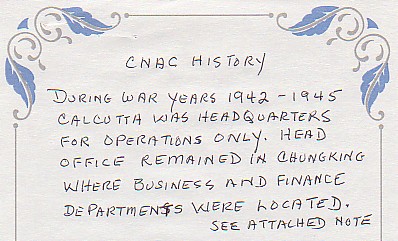 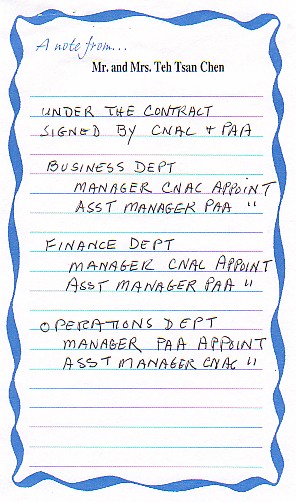 |
|
In 1999 in an effort to preserve some of the CNAC history, Oliver Glenn began writing his recollection of CNAC of 1945-1949 in letter format. Click here for the first letter. Click here for the second letter. Click here for the third letter. Click here for the fourth letter. We will continue to add these letters as long as Captain Glenn writes them. Please check back. Thanks. |
| In mid-2001, Fletcher "Christy" Hanks, wrote a history of CNAC, with a section by Tex that Christy said were italicized, but they are no italicized sections, unless someone has that italicized copy. NOTE: Any of you know the last name of this Tex? |